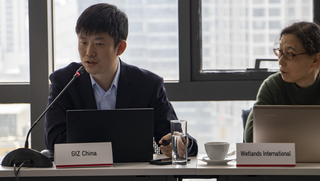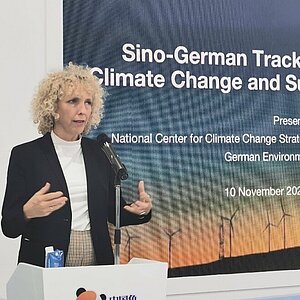IKI Interface Workshop China 2022

IKI projects support China on its path to green development.
The country is a major player in climate change and biodiversity issues, as it is not only one of 12 mega-biodiversity countries, but currently also the country with the highest absolute CO2 emissions.
Focus on the link between climate change and biodiversity
In March this year, the IKI Interface Workshop 2022 was held in China to address the significant interlinkages between biodiversity conservation and climate action. This workshop, attended by 26 IKI projects across 15 implementation agencies, was organized by the Sino-German Cooperation on Climate Change and Climate Partnership, which serves as the IKI Interface Project for China. The annual workshop is designed to promote dialogue between the IKI projects in China and to facilitate exchange on current issues in the fields of climate action and biodiversity. During the hybrid event, the participants discussed the insights and challenges related to their project activities, identified synergies and established connections in their work.
The economic recovery in 2021 caused a rise in greenhouse gas emissions both in China and in Germany, a clear indication of the slow pace of climate action in the two countries. The Fifteenth meeting of the Conference of the Parties to the Convention on Biological Diversity (CBD COP 15), hosted by China, is expected to culminate in the formulation and adoption of a new Post-2020 Global Biodiversity Framework (GBF). With biodiversity protection and nature conservation gaining momentum in China, biodiversity-related issues are gradually featuring in cross-sector discussions.
China’s NDC update
One of the key items on this year’s agenda was NDC implementation and how this can be harmonised with biodiversity conservation. Looking at China’s updated NDCs and their translation into national strategies, it aims to have CO2 emissions peak before 2030 and achieve carbon neutrality before 2060. In order to translate the NDC goals into national strategy, China has put in place a ‘1+N’ policy framework for carbon peak and carbon neutrality. ‘1’ refers to the long-term approach to combating climate change, while ‘N’ refers to solutions to achieve peak carbon emissions by 2030.

Another focus at the workshop was on the development of nature-based approaches to resolving the climate and biodiversity crises. In this context, there were discussions on developing ecosystem-based approaches to adaptation, creating local networks among farmers for biodiversity conservation at community level, and setting up local communities of practice for nature-based solutions.
Another vital point of discussion was the role of finance. Project staff from green infrastructure projects shared their experiences of investments in low-carbon infrastructure and the development of sustainable energy strategies. Financial streams affect both climate and biodiversity and decision-makers need support in promoting holistic financial projects that take account of the financial impact on both spheres.
Climate crisis cannot be solved without simultaneously addressing the loss of biodiversity. In China as in the rest of the world, the wide-ranging aspects of biodiversity and climate change, and the need to strengthen mutual understanding through cooperation and coordination to achieve effective and ambitious implementation need to be taken into focus. This is a stand that all projects present at the workshop, strongly committed to do.
The link has been copied to the clipboard
Contact
IKI Office
Zukunft – Umwelt – Gesellschaft (ZUG) gGmbH
Stresemannstraße 69-71
10963 Berlin





